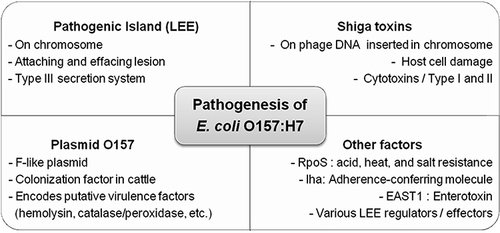Figures & data
Figure 1 E. coli O157:H7 infection. Healthy cattle are the main reservoir of E. coli O157:H7 and temporarily carry this microorganism without any visible symptoms. Contaminated cattle products and culture are the main causes of human infection. Reproduced with permission from Lim JY, Yoon JW, Hovide CJ. A Brief Overview of Escherichia coli O157:H7 and Its Plasmid O157. J Microbiol Biotechnol, 2010;20(1):5–14. Copyright © The Korean Society for Microbiology and Biotechnology. ![]()

Figure 2 Different virulence factors produced by pathogenic E. coli O157:H7 which causes infections. Reproduced with permission from Lim JY, Yoon JW, Hovide CJ. A Brief Overview of Escherichia coli O157:H7 and Its Plasmid O157. J Microbiol Biotechnol, 2010;20(1):5–14. Copyright © The Korean Society for Microbiology and Biotechnology. ![]()

Table 1 Selected Different Classes of Antimicrobial Agents and Their Modes of Action and Resistance Mechanisms*
